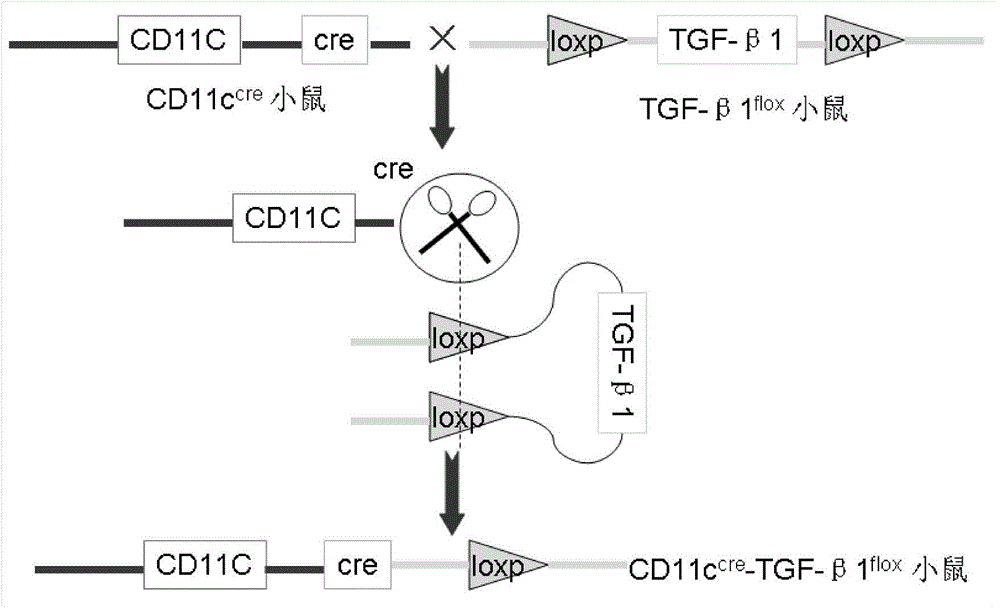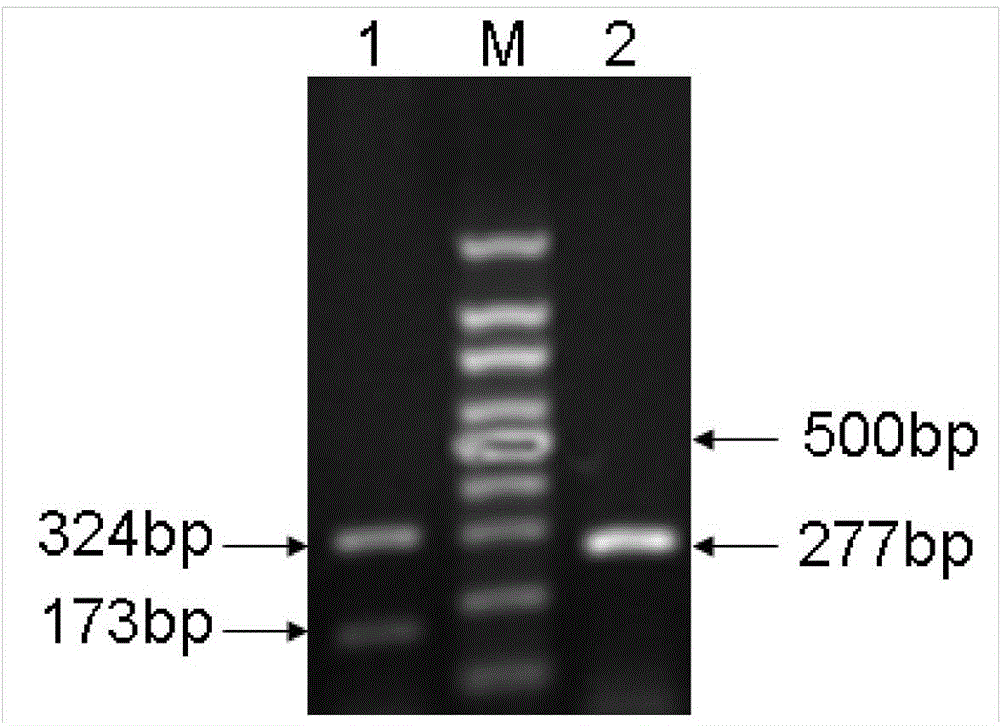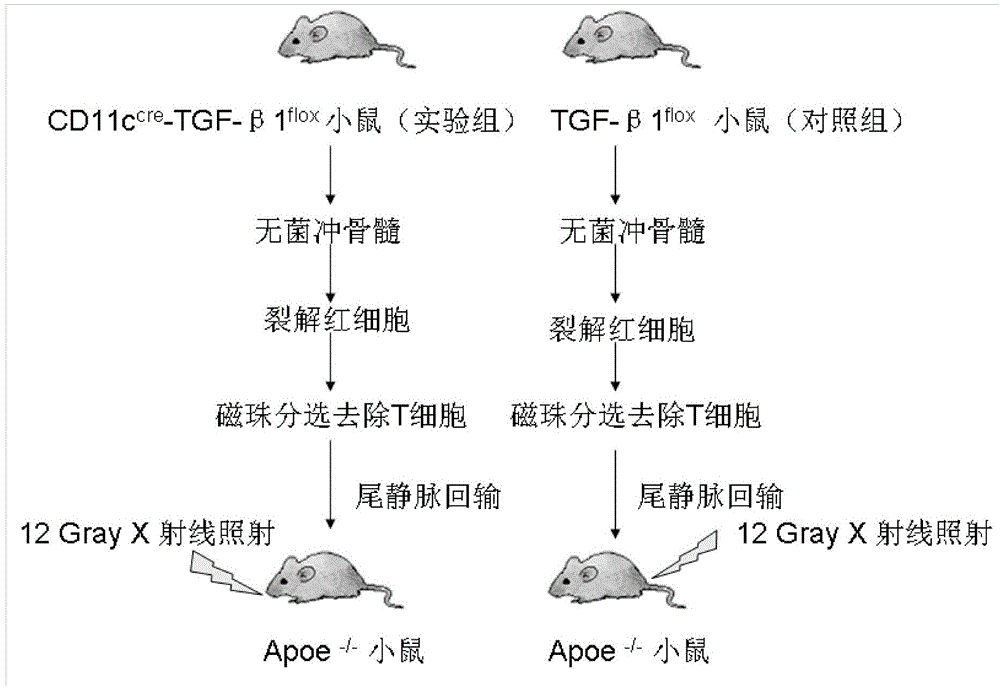Application of dendritic cell expressed TGF-beta 1 (transforming growth factor-beta1) in preparing anti-atherosclerosis medicaments
A technology of atherosclerosis and dendritic cells, applied in the medical field, can solve problems that are unclear and affect the formation of atherosclerotic plaques
- Summary
- Abstract
- Description
- Claims
- Application Information
AI Technical Summary
Problems solved by technology
Method used
Image
Examples
Embodiment 1
[0018] Example 1 Using cre-lox technology to construct DCs that do not express TGF-β1 mice
[0019] The principle of cre-lox technology is: Cre is a recombinase that can catalyze the recombination of two loxp sites, thereby deleting the gene between the loxp sites. In order to use the cre-lox technology to construct mice whose DCs do not express TGF-β1, two kinds of mice, CD11c cre (Catalog No.: 007567) and TGF-β1 flox mice (product number: 010721), and then use the principle of cre-lox technology to cross the two kinds of mice. The principle of hybridization is as follows: figure 1 . The F1 generation mice were identified by PCR, and the genotypes of the offspring were selected as CD11c-cre (transgenic) and TGF-β1-flox (heterozygous) mice and then crossed; in the F2 generation mice, CD11c-cre was selected as the transgene The mice that are homozygous for TGF-β1-flox are then crossed to expand breeding; CD11c-cre (transgenic, hemizygous) and TGF-β1-flox (homozygous) in the ...
Embodiment 2
[0059] Example 2 Using bone marrow chimeric technology to construct Apoe in which DC does not express TGF-β1 - / - mouse
[0060] Apoe - / - Mice are susceptible mice for atherosclerosis. In this experiment, Apoe - / - The mouse is the recipient mouse, and the CD11c constructed above cre -TGF-β1 flox The mice were used as donor mice, and through bone marrow chimera technology, Apoe in which DCs did not express TGF-β1 was established. - / - mice. This technique first aseptically washes out the above-mentioned constructed CD11c cre -TGF-β1 flox Mouse bone marrow, preparation of bone marrow cells due to TGF-β1 flox Genetic background of mice and Apoe - / - Mice have different genetic backgrounds. In order to prevent transplant rejection during bone marrow transplantation, the prepared bone marrow cells are further removed by magnetic bead sorting technology to remove T cells. The bone marrow cells sorted by magnetic beads were reinfused into Apoe irradiated with 12Gray lethal dos...
Embodiment 3
[0083] Example 3 Induction of Apoe through bone marrow chimerism by high-fat diet - / - Atherosclerosis in mice
[0084]The normal feed was fed for 6 weeks after bone marrow chimerism, so that the transplanted bone marrow cells could be rebuilt. After 6 weeks, a high-fat diet (containing 0.15% cholesterol and 21% fat) was continued for 12 weeks to induce the formation of atherosclerotic plaques in mice. The feed was Co60 irradiated and purchased from Beijing Keao Xieli Feed Co., Ltd. At 12 weeks, the plasma total cholesterol and triglyceride levels, atherosclerotic plaque area and plaque / lumen ratio in the aortic root were detected. The specific methods and results are as follows.
[0085] 1. Reagent preparation
[0086] PBS (pH7.2, 0.01M) was prepared by conventional methods; EDTA anticoagulant was prepared by conventional methods; Oil Red O staining kit was purchased from Nanjing Jiancheng Bioengineering Institute; OCT used for embedding tissues was American Cherry Blossom...
PUM
| Property | Measurement | Unit |
|---|---|---|
| Thickness | aaaaa | aaaaa |
Abstract
Description
Claims
Application Information
 Login to View More
Login to View More - R&D
- Intellectual Property
- Life Sciences
- Materials
- Tech Scout
- Unparalleled Data Quality
- Higher Quality Content
- 60% Fewer Hallucinations
Browse by: Latest US Patents, China's latest patents, Technical Efficacy Thesaurus, Application Domain, Technology Topic, Popular Technical Reports.
© 2025 PatSnap. All rights reserved.Legal|Privacy policy|Modern Slavery Act Transparency Statement|Sitemap|About US| Contact US: help@patsnap.com



